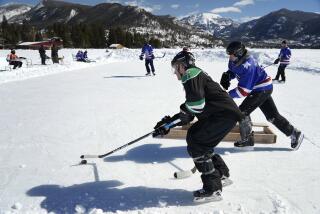Examining Great Lakes, Lousy Weather
MADISON, Wis. — What makes the Great Lakes region such a volatile region for snow and rain also makes it a great place to study the weather.
This winter, researchers are studying swirls of cold wind over Lake Michigan in hope of improving the computer models meteorologists use to forecast the region’s often-unpredictable weather.
For Ed Eloranta, a scientist with the University of Wisconsin Department of Atmospheric and Oceanic Sciences, nasty weather in early January was great news. He sent two graduate students out on a fishing boat into a cloud of fog off the west coast of Lake Michigan.
Once there, they dropped a buoy fixed with equipment that measured the fluctuations of heat from the water into the air. The data was then transmitted to a satellite, sent to a station in Maryland, then to Eloranta’s office in Madison.
The buoy helped with a project called Lake-ICE, or Lake-Induced Convection Experiment, which compares actual weather to what computer simulations say the weather should be.
If the project works, it will help meteorologists better forecast the weather and long-term climate patterns in the lake-effect snow kingdom of the Great Lakes region, said David Kristovich, an organizer of the project.
“In general, we know that when cold air flows over the lakes, there’s going to be heat and moisture outgoing into the air, and if there’s enough and if the conditions are conducive . . . we know that snow will fall,” Kristovich said.
But, he said, reliance on existing equipment doesn’t yield specific enough answers to such questions as how heavy the snowfall will be, where it will hit and how long it will last.
“That’s what we’re trying to get at here,” said Kristovich, an associate scientist with the Illinois State Water Survey who is working out of Ann Arbor for the data-collection phase of the project.
For his Lake-ICE experiments to work, however, Eloranta said researchers need cold winds coming from the north or west, which have been in short supply this winter.
The data-collection phase started in December and runs through the end of January. The project’s headquarters are at the University of Michigan in Ann Arbor.
Other schools involved with the project include Wisconsin, Penn State and the University of Illinois.
The experiment uses two planes equipped with highly sensitive weather instruments. They fly into clouds to measure heat fluctuation and below the clouds to examine the wind eddies that circulate there.
Stations on both sides of the lake in Michigan and Wisconsin, as well as several in Canada, send up balloons to measure air temperature and humidity, as well as wind speed and direction.
At an old Army van near the lake in Sheboygan, Eloranta uses a system known as LIDAR to watch the eddies form as the cold air meets the warmer lake. It is a highly sensitive machine that uses light in the same way a radar uses radio waves.
“Most LIDARs are very specialized and finicky, frankly. They take a lot of persistence to keep them running correctly,” said Shane Mayor, a doctoral student working on the project.
The University of Wisconsin has put the LIDAR results on the Internet, allowing World Wide Web browsers to see a computer rendering of the cold air meeting the warm water.
The LIDAR measures the cold-air wind activity on the lake. Wind eddies swirl over Lake Michigan, building into clouds that dump snow on the lake’s eastern shore.
The project was funded with $1.5 million in grants from the National Science Foundation. Kristovich said scientists will analyze the data for the next few years. The study could yield improved forecasting equipment in about five to 10 years.
“This was put together by a good group of scientific investigators,” said Stephan Nelson, program director for meteorology at the National Science Foundation. “Anyone who’s around the Great Lakes knows about lake-effect snowstorms, and how disruptive they can be on life. . . . Eventually, if everything is successful, it could translate into better forecasts of time and location of lake-effect snow.”
*
The University of Wisconsin Web site for viewing the LIDAR results is https://lidar.ssec.wisc.edu/






